Aman Sharma, Abhishek
CCET-Department of Civil Engineering, Panjab University, Chandigarh, India
Correspondence to: Aman Sharma, CCET-Department of Civil Engineering, Panjab University, Chandigarh, India.
| Email: |  |
Copyright © 2017 Scientific & Academic Publishing. All Rights Reserved.
This work is licensed under the Creative Commons Attribution International License (CC BY).
http://creativecommons.org/licenses/by/4.0/

Abstract
The objective of this paper is to depict and examine road safety of Mohali City, Punjab by quantification of number of fatalities due to factors behind road accidents. The paper also aims to instantiate major causes behind inflating road accidents day by day in an urban area by classifying characteristics of road accidents into mode of transport, month of occurrence, time of occurrence, number of pedestrians and cyclists, type of location and type of collision causing accident. The study also depicts the need to shift to Transit Oriented Developments (TOD) and Bus Rapid Transit (BRT) corridors to assure improved quality of life for the city residents by decreasing air pollution, improving pace and safety of motor drivers as well as pedestrians and cyclists.
Keywords:
Road Accidents, Mohali, Analysis, Bus Rapid Transit, Transit Oriented Development, Pedestrians, Cyclists
Cite this paper: Aman Sharma, Abhishek, Analysis of Road Safety for Pedestrians and Cyclists in Mohali City, India, International Journal of Traffic and Transportation Engineering, Vol. 6 No. 1, 2017, pp. 8-14. doi: 10.5923/j.ijtte.20170601.02.
1. Introduction
‘Road Safety in India’ status report 2015 from the Indian Institute of Technology, Delhi [1], says injuries requiring hospitalization are likely to be underestimated by a factor of four and for all injuries by a factor of 20. For everyone undertaking a road journey, the risk of a fatal accident has been rising steadily: absolute fatalities in 2014 showed a 6 per cent average annual growth rate compared to 1970 figures. Data also show that more than half of those killed last year were in the productive age group of 15 to 34, pointing to a calamitous loss of young lives. This is a public health crisis that requires prompt action. Recently, Ministry of Road Transport, India released a report evincing that 146,1331 people were killed in road accidents in India in 2015, up from 139,67112 in 2014. 400 road deaths took place every day on the roads of 13 Indian states, including Punjab and Chandigarh, answered for more than 80% of all road accidents and deaths. Sweeping the majority among other factors behind road accidents, over speeding was found to have 62% of the share of all accidents with nearly 8 in 10 accidents were caused by neglectful drivers. The proliferating growth of traffic, the greater percentage share of cars used for transportation, driver impairment, over speeding are some primal factors behind accidents which have in turn led to swelling need for developing the road infrastructure. In general, pedestrians, cyclists, and moped and motorcycle riders are the most vulnerable road users as well as the heaviest users of roads in developing countries. In the main, pedestrians and cyclists, the rifest users of roads are left unguarded in developing areas which require improvement of infrastructure for protecting human lives.
2. Need for Study
A perennially mushrooming population and a rapidly growing middle class are placing an additional burden on the already concentrated transport network. This burgeoning growth of vehicles in collaboration with the sharing of restricted right of way by a mixture of modes and other utility facilities has heightened problems such as traffic over-crowding, oft accidents, and deficient parking area and environment deterioration. The usage of private means of transportation in the form of private cars, motorbikes, three-wheelers is expanding unabated majorly due to ineffectual public transport facilities. Road accidents caused by a number of factors such as inaccurate geometric design of pavements, idle use of traffic roadway signs and markings, improper design of traffic flow system, usage of faulty traffic technologies etc. are certain to grow in multiplication unless progressive actions towards common good are taken. Also, incompetent traffic handling particularly in respect of the rash driving of buses, minibuses and auto rickshaws, inefficient traffic monitoring at intersections, absence of public awareness, undefined bus stops. are few causes which are resulting in greater usage of private transportation. This, in turn, results in greater sizable threat to pedestrians and cyclists and further leading to road accidents. To tackle this difficult problem emerging in most of the urban areas, Transit Oriented Development and Bus Rapid Transit systems are being recommended and installed by respective governments to ensure a safer and better future.To ensure greater safety of pedestrians and cyclists and efficacious movement as well, Transit-oriented development (TOD) which focuses on encouraging mixed-use residential and commercial development surrounding public transport stops was observed to be best suited to fulfil the demands of the city, for which the Chandigarh Government has already started work upon and aims to achieve the same by 2031. Bus Rapid Transit (BRT) is defined as a corridor in which buses operate on a dedicated right-of-way such as a busway or a bus lane reserved for buses on a major arterial road or freeway. The BRT corridor provides dedicated lanes for pedestrians, cyclists, and buses, yielding an incentive for people utilizing public transport while also guaranteeing more clean distribution of space on urban roads and also undertake the alarming universal problem of air pollution. BRT corridors with intelligent and effective design, urban cities can lessen road users risk and salvage lives on a national as well as global scale. Keeping in sight these current problems and growing need for the betterment of transport infrastructure of the city, installation of BRT corridors has been recommended in cities of Mohali and Panchkula along the sectors grid, at the interstate bounds of Chandigarh and Punjab.
3. Data Depiction and Analysis
 | Figure 1. Percentage Share of People Died In Road Crashes by Different Vehicles in Mohali, India (Source: Office of the Traffic Advisor, Punjab) |
Observations: Figure 1 renders that cars and trucks have contributed to 71 % of the road crashes taken place in Mohali city in last 3 years out of which total of 53 % of crashes was caused by car alone, thus, proving to be the most dangerous vehicles among all other types of motor vehicles. | Table 1. Total Number of Crashes, Number of People Died and Percentage of Pedestrians & Cyclists Died in Year 2013-14-15 in Mohali, India |
Observations: From the above table, it can be comprehended that though, the total number of crashes and number of people died have not increased (nearly constant) but the percentage share of the number of pedestrians and cyclists in road crashes have increased from 38% to 56%, thus, making the city unfit for the safe pedestrian and cyclist movement. As depicted in Table 1, in last three years (2013-2015), 21 pedestrians lost their lives, at 21 different locations in Mohali municipal limits. Not a single pedestrian accidental death occurred at the locations where pedestrian foot over bridges were built. 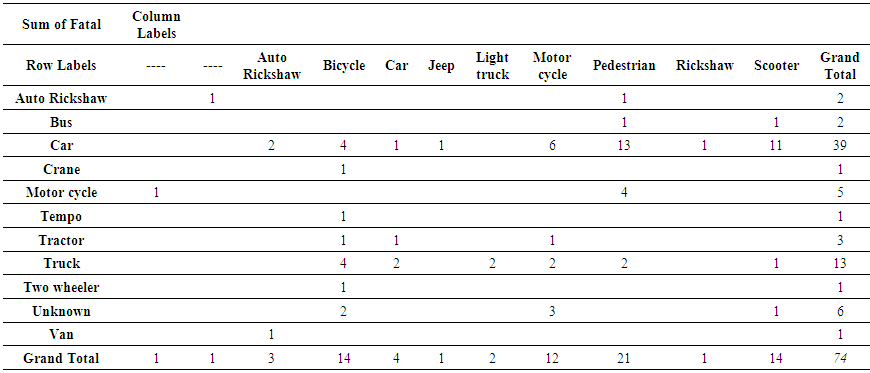 | Table 2. First Vehicle to Second Vehicle Fatalities in Mohali, India |
Observations: In Table 2, Column label refers to the First vehicle (culprit) and Row label refers to the Second vehicle (victims) followed by the number of people died due to a collision. It is clear that the vehicles involved in most of the road crashes are cars & trucks killing pedestrians and cyclists. Both car and truck are involved in 52 out of the 74 road crashes happened in the city for past 3 years. | Figure 2. Total No. of Pedestrians & Cyclists Died during Year 2013-14-15 in Mohali, India |
Observations: From Figure 2, it is clear that the total number of pedestrians and cyclists killed in road crashes have increased at an alarming rate.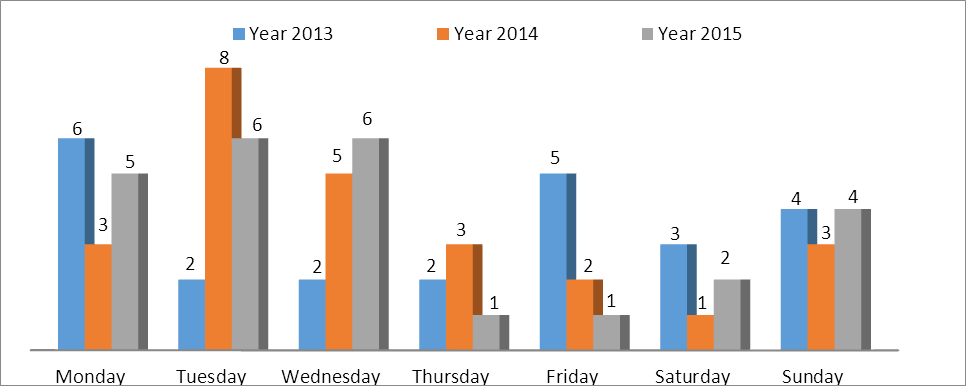 | Figure 3. Day - Wise Total number of Persons Died in Mohali, India |
Observations: Figure 3 shows that in last 3 years, the number of crashes has been increased on first 3 days of the week i.e. Monday, Tuesday, and Wednesday and gradually decreases on the next 3 days, being maximum crashes on Tuesday.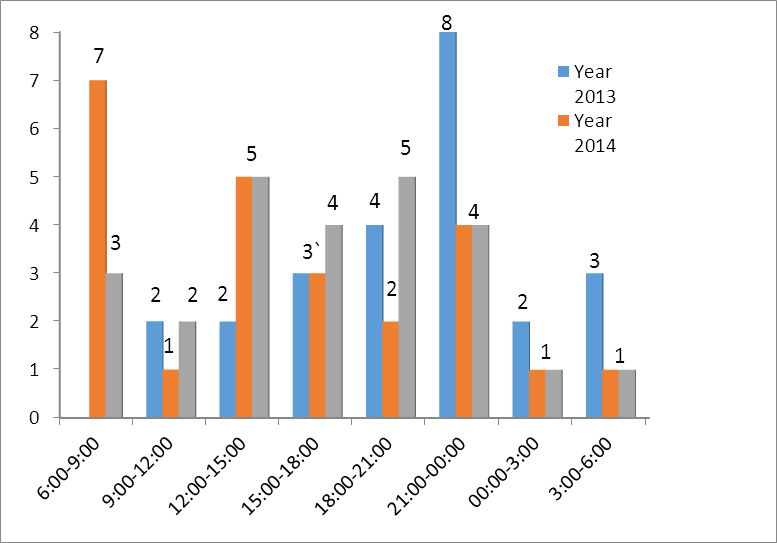 | Figure 4. Distribution of No. of People Died As Per Time of Occurrence in Mohali, India |
Observations: From the Figure 4, it is observed that the maximum road accidents occurred during the peak hours of the day i.e. 12:00-15:00, 15:00-18:00, 18:00-21:00 & 21:00-00:00 time intervals when there is a maximum movement of the people on road i.e maximum vehicular traffic. | Figure 5. Total No. of People Died Classified According to the Type of Location in Mohali, India |
Observations: Figure 5 evinces that in Mohali, Road section crashes has been increased in the year 2013-14-15 whereas near junction crashes has gradually decreased. The wide straight roads might be one of the reasons for increasing road section crashes. | Figure 6. Total No. of People Died Classified According to the Type of Collision in Mohali, India |
Observations: It was observed that ‘Hit from back’ and ‘pedestrian’ crashes has been gradually increased every year. In last three years, ‘Hit from back’ collision has increased from 3 to 7.
4. Ground Observations
4.1 No kerb markings and Reflectors were provided on the slip road at Sector 66-67, Phase 10-11 Intersection, as shown in Figure 7, where it can be dangerous to drive at night time. There is also a Pot-hole at the entrance of the slip road which may lead to be a reason for crashes, causing the vehicles to misbalance while taking a turn.4.2 No channelization for slip road at the area intersection on Phase 11 Sector-66 Phase 9, Jagatpura Road shown in Figure 8. The pedestrian had to cross large distance at once causing the disruption to the vehicles taking left turn & also endangers the safety of pedestrians. Secondly, No Timers were provided at the intersection causing the wastage of fuel as the unpredictability of having Green Light signal at any moment occurs.4.3 No provision for the cyclists at the Road section is provided which can be seen in Figure 9. From last 3 years data as cited before, it has been evaluated that the fatal road crashes of 4 cyclists occurred at this road in last three years, making the road dangerous for the movement of cyclists and pedestrians. 4.4 Standardized construction as per the IRC guidelines was not done on Forest Complex Intersection, displayed in Figure 10, as no median opening was provided prior to the crosswalks which completely makes the construction wrong. A proper opening should be provided for the movement of the pedestrians.4.5 Poor visibility of the Informatory sign board, as shown in Figure 11, is caused due to the growth of tree branches at Kumbra chowk traffic lights point.4.6 No timers were observed at Spice Chowk Intersection. (Figure 12). 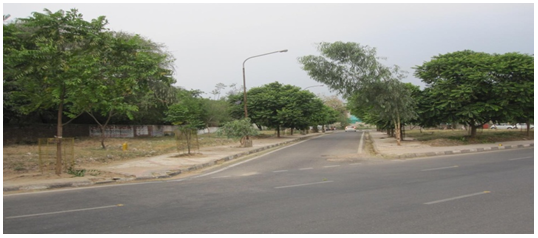 | Figure 7. Sec 66-67/ Phase 10-11 Intersection, Mohali, India |
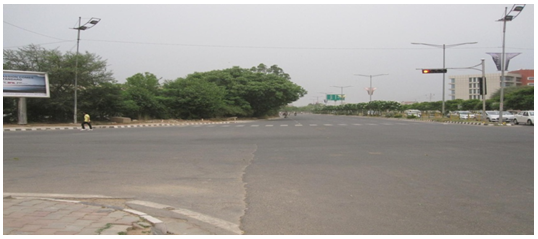 | Figure 8. Phase 11-Sector 66- Phase 9 Ind. Area Intersection, Mohali, India |
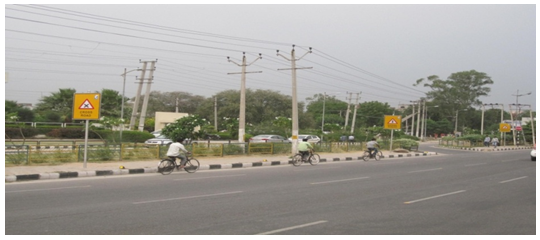 | Figure 9. Road Section Heading Towards Phase 11-Sec 66- Phase-9 Intersection, Mohali, India |
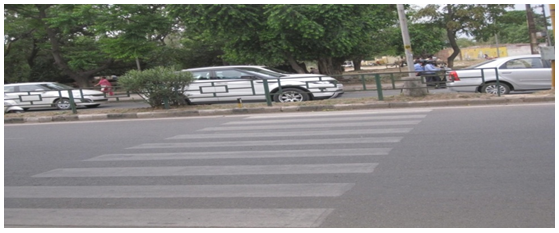 | Figure 10. No Median Opening Provided Prior to Crosswalk at Forest Complex Intersection, Mohali, India |
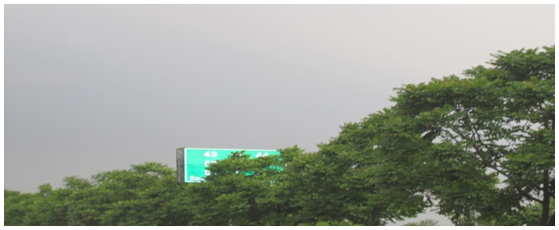 | Figure 11. Obstruction in Visibility of the Informatory Sign Board at Kumbra Chowk Intersection, Mohali, India |
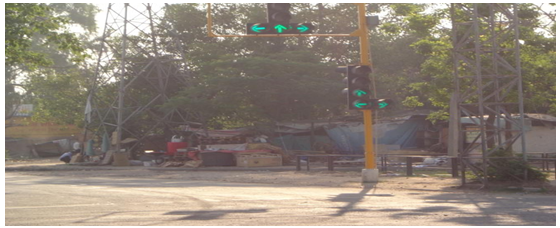 | Figure 12. No Timers on Traffic Lights, Mohali, India |
5. Conclusions
Pedestrian collisions are both predictable and preventable and occur due to several parameters categorized into driver behaviour stimulating over-speeding and driving under alcohol ingestion, lack of infrastructure i.e. deficient facilities for pedestrians such as footpaths, raised crosswalks and medians. Road markings such as cycle lane marking, traffic lanes, pedestrian crossings which assist in checking traffic by means of mental allurement of road commuters and thereby assisting safe pedestrian crossing, which is one amongst other major factors, if not tackled, poses a high and constant risk of fatal road crashes in Mohali City. For risk-free and prompt mobility of pedestrians and cyclists in the city, informatory road signs should be provided which serve as a means of guidance for driver on facilities in the form of route and distance information. Comprehensive use of Red-light timers that permit timed vehicular movement and also bears environmental advantages, shall be used on roads dealing with greater vehicular traffic. Signalized pedestrian crossings should be installed where greater bulk of pedestrian traffic is observed as it facilitates an expedient and safer motility of pedestrians. It was observed that in past 3 years’ period, road crashes with pedestrians and cyclists are increasing at an alarming rate in Mohali and preventive measures should be taken to overcome growing fears for non-motor users. This paper aims to lay emphasis on Transit Oriented Development and BRT Corridors installation that would improve public transport quickness, accrued transport capacity and would ameliorate facilities for pedestrians and cyclists by provisioning of pedestrian sidewalks and over head bridges across the corridor. Also, adequate provisions for park and ride concept at BRT stations would also ease assemblage of bicycles with the mass transport system and ensure last mile connectivity to the passengers.
Note
1,2. Road Accidents in India, 2015. Ministry of Road Transport and Highways, Government of India.
References
| [1] | IIT Delhi (2015). Road Safety In India Status Report. |
| [2] | Tom V. Mathew and K V Krishna Rao. Introduction to Transportation Engineering 37.9. |
| [3] | Mohan D. Delhi: Indian Institute of technology Delhi (2004). The Road Ahead; Traffic injuries and fatalities in India. |
| [4] | Munivenkatappa A, Devi BI, Gregor TI, Bhat DI, Kumarsamy AD, Shukla DP (2013). Bicycle accident related head injuries in India. Journal of Neurosciences in Rural Practice; 4: 262–66. |
| [5] | L. R Kadiyali (1987). Traffic Engineering and Transportation Planning. Khanna Publishers, New Delhi. |
| [6] | Baguley. C., (2001). Road Safety Management of the Highway Network, International Symposium on Traffic Safety Strengthening and Accident Prevention, Nanjing, China. |
| [7] | Ministry of Road Transport and Highways, India (2015). Road Accidents in India. |
| [8] | Mondal. P. (2011). A Silent Tsunami on Indian Road: A Comprehensive Analysis of Epidemiological Aspects of Road Traffic Accidents, British Journal of Medicine & Medical Research, 1(1): 14-23, 2011. |
| [9] | Robert B. Noland, Ph.D. Kaan Ozbay, Ph.D. Stephanie DiPetrillo Shri Iyer (2014). Measuring Benefits of Transit Oriented Development. |

















 Abstract
Abstract Reference
Reference Full-Text PDF
Full-Text PDF Full-text HTML
Full-text HTML